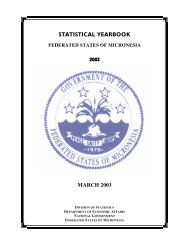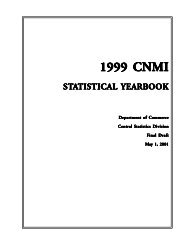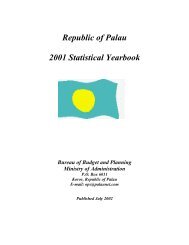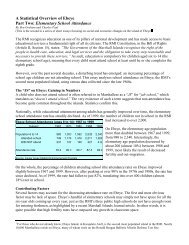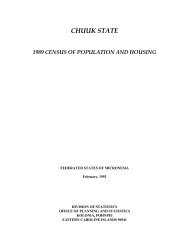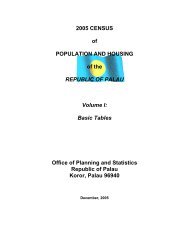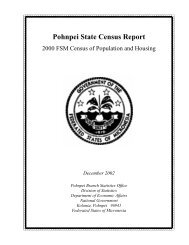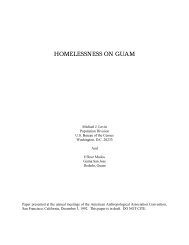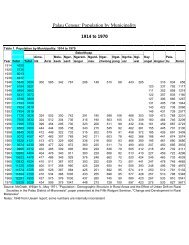Chuuk State Census Report - pacificweb.org
Chuuk State Census Report - pacificweb.org
Chuuk State Census Report - pacificweb.org
You also want an ePaper? Increase the reach of your titles
YUMPU automatically turns print PDFs into web optimized ePapers that Google loves.
CHAPTER 5MORTALITYIntroductionAs reported in Chapter 4, fertility rates in the <strong>State</strong> of <strong>Chuuk</strong> declined over nearly three decades before the 2000<strong>Census</strong>. However, mortality rates of <strong>Chuuk</strong> had already been brought to a moderately low level and thus little declineoccurred in between 1994 and 2000. In this chapter mortality is estimated directly from available registration data, andindirectly from recent censuses in the FSM to find the level and trend of mortality over time in the FSM.Data DescriptionMortality cannot be estimated through direct methods from the census data because no direct questions were askedregarding deaths. Indirect estimates of early age mortality can be derived from the questions concerning children everborn and children still alive (questionnaire item 17a). The proportion of children surviving can be applied to model lifetables to produce basic mortality rates. Children ever born and surviving were asked to women in the 1973, 1980, 1989and 1994 <strong>Census</strong>es as well and data are provided for comparison.Mortality indices of interest are crude death rate, infant mortality rate, child mortality rate, and life expectancy at birth.The crude death rate (CDR) is the most common direct measure of mortality and is defined as the number of deaths per1,000 persons. Similar to the crude birth rate, the crude death rate is dependent on the age-sex structure, thus it is acrude measure. An adjustment on the CDR must be made before any attempt to compare mortality over time or fordifferent regions or countries can be made. The infant mortality rate (IMR) is defined as the number of infant deathsper 1,000 live births during the year. The IMR is a good indicator of the quality of health care in a nation becausemortality is high during the first months of life and small improvements can be measured. It is also an adjustedmeasure that is not dependent on the age-sex structure of a region. The child mortality rate is defined as the probabilityof dying between ages 1 and 5. Life expectancy at birth is the average number of years a newborn baby can expect tolive, given the current level and pattern of mortality. Unlike the crude birth rate this measure is independent of the agestructure of a nation and is thus a good measure for comparison between countries or regions.Life expectancy is obtained from a life table constructed based on a set of age specific death rates, from whichprobability of surviving to a specific age is determined. These survival probabilities are applied to an assumed cohortof births that occurred in the same year, following the survivors as they reach successive ages until all have eventuallydied. From the total number of all years lived, probability of survival between the ages and life expectancies at thevarious ages is estimated (see Arriaga, E.E. et al., 1994 pp 74-83 for details on the derivation). In <strong>Chuuk</strong>, however,deaths are under-registered, making it difficult to obtain the life table from age specific death rates calculated fromregistration data. As an alternative, a life table implied by childhood survivorship ratios has been presented in thischapter.Analysis of Mortality DataDirect measures of mortality could be calculated using deaths registered with the Department of Health. Unfortunatelythese events are under-registered and inconsistently covered, providing only a guide to the patterns of mortality but notto the level. To compensate for the different levels of coverage and to smooth some erratic patterns, Table 5.1 presentstwo four-year averages of mortality rates. In both cases the CDR was approximately four per thousand which is anunder count. The CDR is calculated using the total number of deaths in a year divided by the estimated mid-periodpopulation. Age-specific mortality rates in the case of the <strong>Chuuk</strong> were erratic and inaccurate because of the smallnumber of persons and deaths and because of inaccuracies in reporting.Crude Death RateThe crude death rate, based on the registration system, is likely to be an underestimate due to under-registration ofdeaths. In order to get better estimates of mortality, an indirect method was used to calculate child and infant mortalityand find a model life table applicable to the <strong>State</strong> of <strong>Chuuk</strong>. The life table is basically a statistical model of mortalityexperience based on given mortality rates. Model life tables allow us to project mortality rates (and other demographic<strong>Chuuk</strong> Branch Statistics Office, Division of Statistics, FSM Department of Economic Affairs 43



